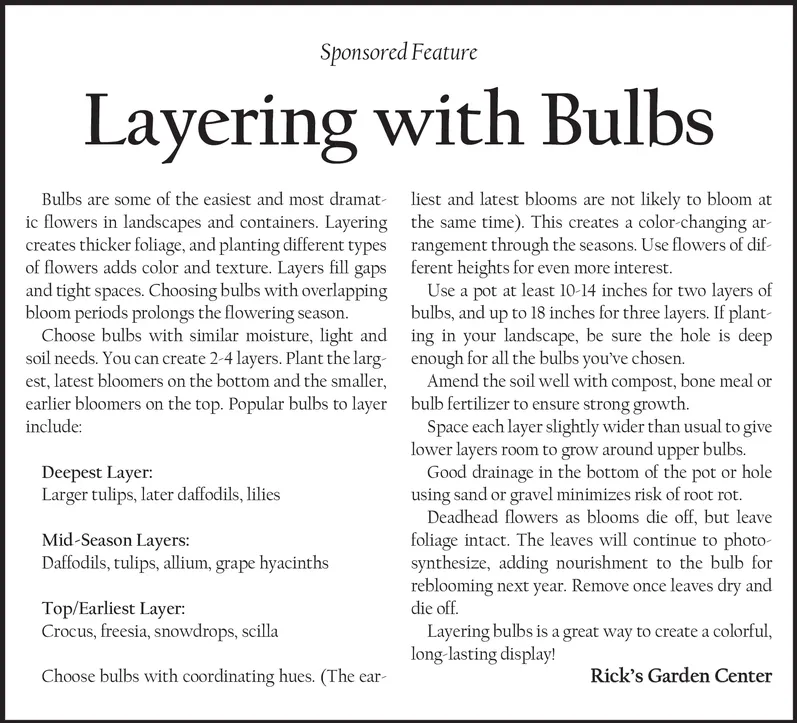Advertisement

-
Published Date
August 31, 2019This ad was originally published on this date and may contain an offer that is no longer valid. To learn more about this business and its most recent offers, click here.
Ad Text
Sponsored Feature Layering with Bulbs Bulbs are some of the easiest and most dramat ic flowers in landscapes and containers. Layering creates thicker foliage, and planting different types of flowers adds color and texture. Layers fill gaps and tight spaces. Choosing bulbs with overlapping bloom periods prolongs the flowering season. Choose bulbs with similar moisture, light and soil needs. You can create 2-4 layers. Plant the larg est, latest bloomers on the bottom and the smaller, earlier bloomers on the top. Popular bulbs to layer include: liest and latest blooms are not likely to bloom at the same time). This creates a color-changing ar rangement through the seasons. Use flowers of dif ferent heights for even more interest. Use a pot at least 10-14 inches for two layers of bulbs, and up to 18 inches for three layers. If plant- ing in your landscape, be sure the hole is deep enough for all the bulbs you've chosen. Amend the soil well with compost, bone meal or bulb fertilizer to ensure strong growth Space each layer slightly wider than usual to give lower layers room to grow around upper bulbs. Good drainage in the bottom of the pot or hole using sand or gravel minimizes risk of root rot Deadhead flowers as blooms die off, but leave foliage intact. The leaves will continue to photo synthesize, adding nourishment to the bulb for reblooming next year. Remove once leaves dry and die off. Deepest Layer: Larger tulips, later daffodils, lilies Mid-Season Layers: Daffodils, tulips, allium, grape hyacinths Top/Earliest Layer Crocus, freesia, snowdrops, scilla Layering bulbs is a great way to create a colorful, long-lasting display! Rick's Garden Center Choose bulbs with coordinating hues. (The ear Sponsored Feature Layering with Bulbs Bulbs are some of the easiest and most dramat ic flowers in landscapes and containers. Layering creates thicker foliage, and planting different types of flowers adds color and texture. Layers fill gaps and tight spaces. Choosing bulbs with overlapping bloom periods prolongs the flowering season. Choose bulbs with similar moisture, light and soil needs. You can create 2-4 layers. Plant the larg est, latest bloomers on the bottom and the smaller, earlier bloomers on the top. Popular bulbs to layer include: liest and latest blooms are not likely to bloom at the same time). This creates a color-changing ar rangement through the seasons. Use flowers of dif ferent heights for even more interest. Use a pot at least 10-14 inches for two layers of bulbs, and up to 18 inches for three layers. If plant- ing in your landscape, be sure the hole is deep enough for all the bulbs you've chosen. Amend the soil well with compost, bone meal or bulb fertilizer to ensure strong growth Space each layer slightly wider than usual to give lower layers room to grow around upper bulbs. Good drainage in the bottom of the pot or hole using sand or gravel minimizes risk of root rot Deadhead flowers as blooms die off, but leave foliage intact. The leaves will continue to photo synthesize, adding nourishment to the bulb for reblooming next year. Remove once leaves dry and die off. Deepest Layer: Larger tulips, later daffodils, lilies Mid-Season Layers: Daffodils, tulips, allium, grape hyacinths Top/Earliest Layer Crocus, freesia, snowdrops, scilla Layering bulbs is a great way to create a colorful, long-lasting display! Rick's Garden Center Choose bulbs with coordinating hues. (The ear
